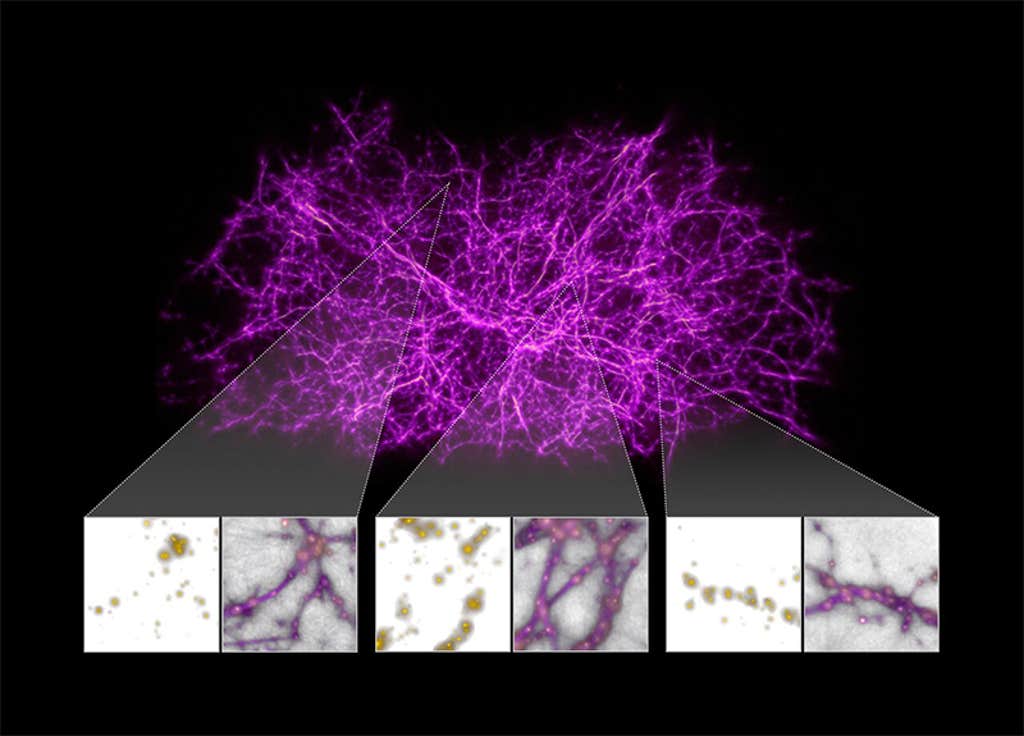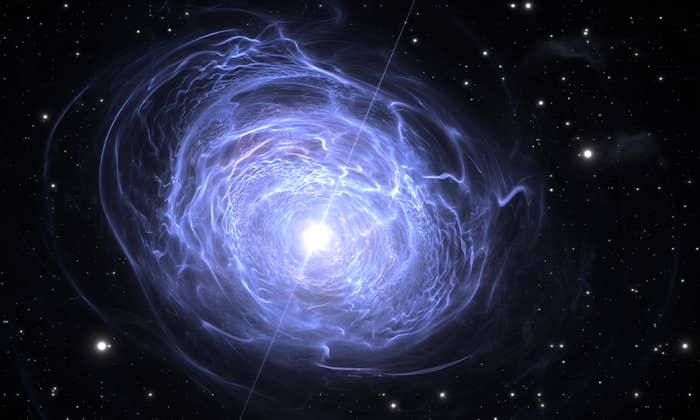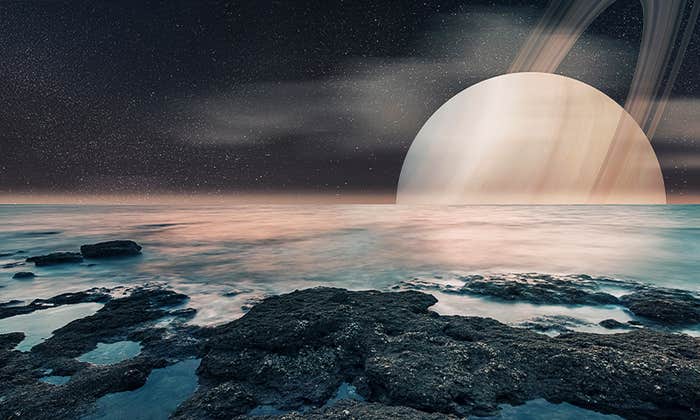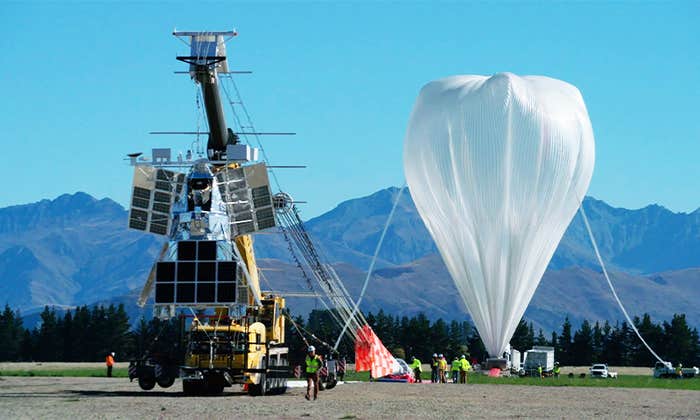In 1985, astronomers found something strange in the sky. After mapping the positions of thousands of galaxies in our neighborhood of the universe, they saw an unexpected pattern emerge: a stick figure. The galaxies clustered to form a central body that stretched for millions of light-years, a knobby head, two arched legs, and outstretched arms.
Resembling something out of the Lascaux cave, the “Stickman” drew immediate international attention. Not because it was an actual cosmic being, of course, but because it clearly showed what many astronomers were beginning to suspect: Galaxies are not scattered about randomly in our universe. Instead, they exist in a pattern, dubbed the cosmic web.
The cosmic web holds the vast majority of the contents of the cosmos—roughly 5 percent matter (such as gasses and solids), 27 percent dark matter, and 68 percent dark energy. And it spans the entire universe, traversing otherwise relatively empty cosmic voids. It serves as the scaffold responsible for carrying the plasma lifeblood of our universe. It is the reason we exist at all.
The story of dark matter and dark energy is written in the web of galaxies.
It is, however, devilishly hard to get a handle on. For one, it’s invisible. We can only begin to discern its filaments’ contours by spotting galaxies, as those that emerged in the Stickman. Also, it’s just really big. The cosmic web fills up the volume of the universe and contains up to 2 trillion galaxies, of which we’ve mapped far less than 1 percent.
But mapping the web wouldn’t just provide us with a better picture of our universe, it also promises to reveal tantalizing information about some of the biggest questions in cosmology about what dark matter and dark energy are, how they behave, and whether they change over time. And answering those mysteries might reveal the ultimate fate of our universe.
Efforts using tried-and-true astronomical models to develop a cartography of the cosmic web have continually come up flat. So astronomers are taking up some unconventional approaches, applying principles of origami, spiders’ webs, and even slime molds, to try to understand the structure of this life-giving network.
The cosmic web, the thinking goes, found its seeds in the earliest moments of the Big Bang, but began taking on its contemporary shape a few hundred million years later. The cause was nothing more than simple gravitational attraction. Initially the gas that filled the universe was almost perfectly uniform, with no big differences from place to place. But soon, even the tiniest of differences began to grow, with regions of higher density pulling on their surroundings, building themselves up and collapsing under their own gravitational weight.
But that collapse did not happen uniformly in all three dimensions. By random chance, one dimension will be slightly more unstable than the others and collapse first. With gravity doing the work of pulling the universe’s loose collections of matter into small, tight, dense balls, it will first pull on the matter in one direction, forming a wall, then on the second, creating a filament, and finally the third, forming a cluster—the birthplace and home of galaxies.

So what astronomers have detected as the cosmic web today is actually bits of matter all caught in various stages of collapse, with the strand-like filaments as an intermediate step between initial general unstructuredness and the finality of a cluster. For example, the Stickman’s head is a completely collapsed cluster, and its limbs are filaments still in the process of formation.
Earlier this year, pulling from new data gathered by the James Webb Space Telescope, an international team of researchers discovered a baby filament containing just 10 galaxies that likely formed a mere 830 million years after the Big Bang, confirming that these filaments were important structures right from the earliest days of the universe.
In addition to the gravitational pull of normal matter, there are of course, the forces of dark matter and dark energy at work, shaping the cosmic web. Combined, dark matter and dark energy make up 95 percent of all the energy contents of the universe—there’s no way that the web won’t be influenced by them. Dark matter provides the gravitational backbone that allows the web to form in the first place, while dark energy is slowly starting to unravel it. Observations of the web, especially its evolution over the past few billion years, will hopefully reveal this push-pull dynamic that plays out on the cosmic stage.
In other words, the story of dark matter and dark energy is written in the web of galaxies that stretches across the universe. We just have to untangle it.
The earliest attempts to map out the filaments relied on stacking. Find pairs of clusters and map out all the galaxies between them. Repeat as many times as your survey will allow, which was precisely the approach that first gave us the Stickman. Each individual filament will not tell you much about any of the grand cosmic mysteries, but dozens or hundreds of filaments stacked on top of each other will give you some generic sense of their behavior. From there, astronomers can build a very broad sense of their properties, which in turn relate to the fundamental cosmological properties of the universe, such as the amount of dark matter or the rate of cosmic expansion. However, this is a very rudimentary approach that lacks the statistical rigor required for precision analysis.
Since most of the universe (that is, dark matter and dark energy) are invisible to direct observations, we have to rely on computer simulations to establish the links between these hidden components of the web and the populations of galaxies that we can see. And so it’s essential to develop reliable web-mapping techniques that work both in simulations and in real surveys, to allow us to fully understand the role that the web and its components play in the universe’s evolution. Which is where the surprising art- and nature-inspired models are coming in handy.
From what we do understand of the cosmic web, much of its shape can be explained by the mathematics of origami folding. If you take a sheet of paper and start folding it, you will find a series of nodes and filaments. The filaments are the simple creases, and the nodes are the places where the creases intersect. Mathematicians have studied the relationships of the creases and folds of origami structures (because that’s the kind of stuff that mathematicians like to do), and astronomers have taken that language and applied it to the cosmic web.
You can imagine the clusters of galaxies as the cores of slime mold colonies.
It’s a little hard to think about, because the formation of the cosmic web already takes place in three dimensions, but if you imagine all the matter of the universe as a perfectly smooth sheet, you can fold that sheet in a specific way to recreate the cosmic web, with empty expanses of voids scattered throughout. This allows astronomers to use that same mathematical language to identify and classify components of the web—where the filaments are, how long they are, how far apart the nodes are, etc.—which in turn might start to give us new insights about the fundamental nature of those sneaky shaping-forces, dark matter and dark energy.
The term “cosmic web,” of course, isn’t just a turn of phrase. It also closely matches the topology—i.e., the general properties, like the relationships among the various holes—of a spider’s web, and the mathematical description of one mirrors the other. A spider web consists of nodes that can support the threads against destructive forces—gravity, wind, interlopers—through tension. If you imagine the clusters of the cosmic web trying to network themselves together with tension-carrying ropes, it turns out, you get the correct structure and distribution of galactic filaments.
The spider’s web and origami research tell us that there is a deep mathematical structure hidden within the pattern of filaments that make up the web. In turn, those mathematical structures are related to the properties of the cosmic filaments we are interested in, like their sizes and shapes and behavior, and how those properties connect to the big and vexing questions we are trying to answer. In particular, the researchers who explored the spider web model showcased mathematical tools for measuring the rotational flows within filaments, a property that has thus far been difficult to measure but is very dependent on the nature of dark matter.
And then there are the slime molds. The organism Physarum polycephalum searches for its food by starting from nodes and building interconnected networks, all while using as few resources as possible to do so. The end result is a compact network that, mathematically at least, resembles the topology of the cosmic web. Enterprising astronomers have already begun incorporating networks inspired by slime molds into their classification of galactic filaments.
The Stickman’s head is a completely collapsed cluster.
The mathematics of slime mold networks provided the researchers with a powerful and efficient platform for identifying filaments and more precisely quantifying their shapes, allowing them to bridge the gap between theoretical simulations and real observations. In this case, you can imagine the clusters of galaxies as the cores of slime mold colonies, and the filaments between them as the networks connecting them in their search for food. While the evolution of slime molds doesn’t mirror the actual physical formation mechanism of the cosmic web, it gives a surprisingly accurate way to classify and characterize the parts of the cosmic web, especially its filaments. Astronomers hope to use this classification to extract more useful information from the structures of the web about dark matter and dark energy.
In the meantime, scientists are also deploying machine learning methods—and of course the latest telescopes—to try to look straight into the distant reaches of the web itself in other wavelengths of light. For example, astronomers recently identified filaments not in traditional galaxy chains, but also in the faint absorption of ultra-hot gas. The next major space observatory, the Nancy Grace Roman Telescope, expected to launch in 2027, will pinpoint the locations of millions of galaxies in visible and infrared wavelengths, allowing it to map a much broader and deeper portion of the cosmic web than ever before. And the Vera Rubin Observatory, a gigantic ground-based telescope expected to begin operating in 2025, will provide a map of more than 20 billion galaxies—far more than the mere millions scientists have charted so far.
As detailed maps of Earth’s continents and their behavior helped elucidate the forces at work on our planet as well as its geological past and future, these cosmic maps promise something similar; namely, getting to the core of the mysterious dark forces of our universe, whose dynamics are both subtle and large-scale. Like the movement of continents or the slow expansion of a seafloor, they only affect the motions of galaxies at the very biggest scales.
And those big scales just happen to have created the right conditions for us to be here now, hanging in our small part of the vast cosmic web. Which makes mapping it seem like a worthy expedition, even if we have to lean on a humble slime mold to help find our way. ![]()
Lead image: HAMONT / Shutterstock

























